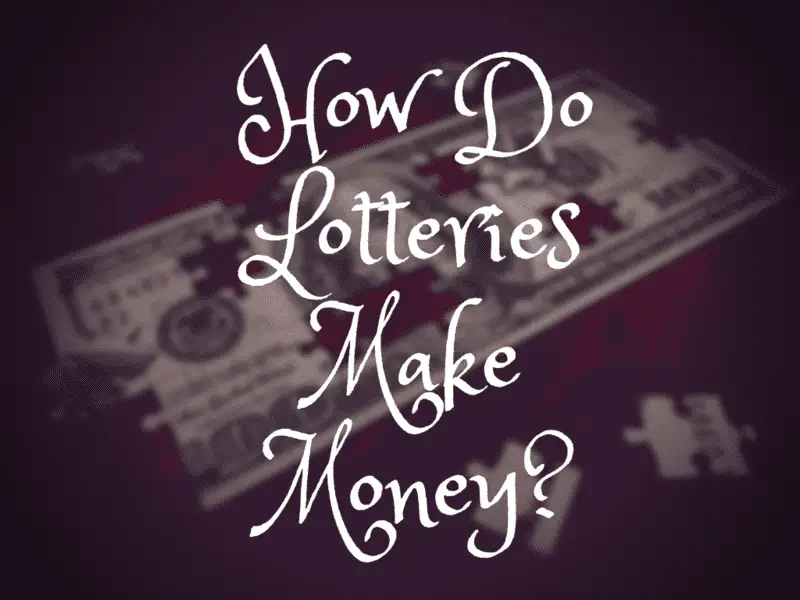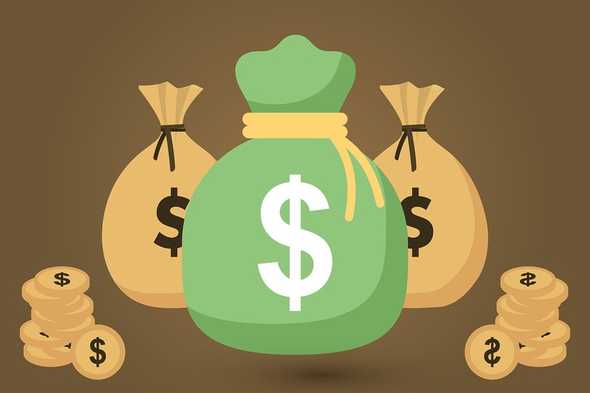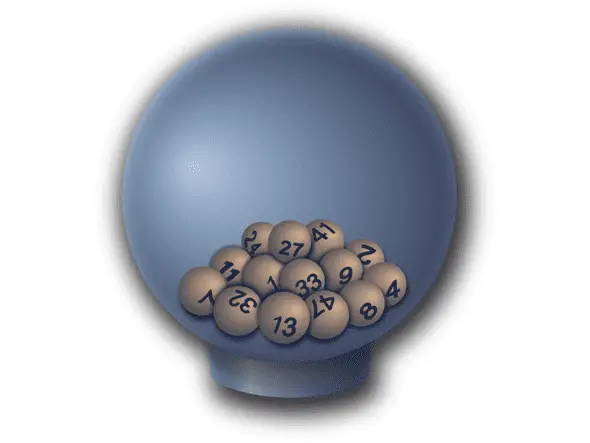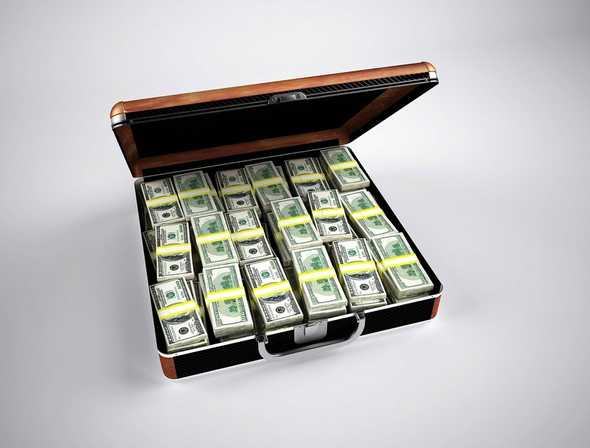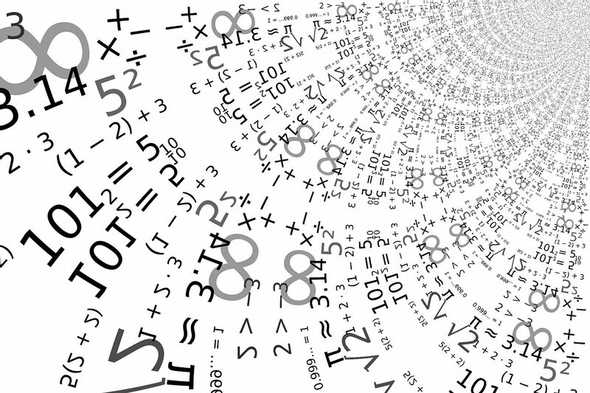How Do Lotteries Make Money?
When you see jackpots in the billions of dollars, it’s no wonder you’re asking how lotteries make money. When a ticket for those mega jackpots costs just $2, it makes you wonder even more. What with the enormous prizes, the advertising, and administration costs, how can there be much left?
Lotteries make money by limiting prize funds to only a proportion of ticket sales, with winners sharing that fund. For fixed prize games, lotteries make money by attaching the odds to prize value, limiting payouts, and keeping payouts at manageable levels.
In essence, therefore, lotteries are like any other business seeking revenue while controlling cost and risk. In this article, you’ll find out how, so, despite the big jackpots, lotteries still walk away with a profit.
What Is a Lottery?
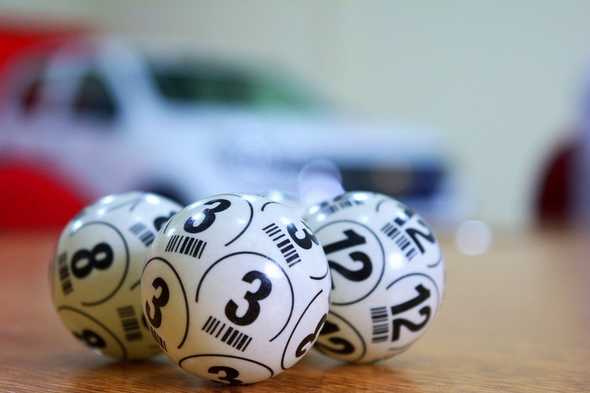 So, let’s start at the beginning. A lottery is a game of chance that involves a random draw to determine a winner or winners.
So, let’s start at the beginning. A lottery is a game of chance that involves a random draw to determine a winner or winners.
A lottery is often used as a decision-making process. A good example you may be familiar with is the NBA Draft Lottery. That’s a draw to determine which team gets the first pick of the draft pool.
However, where you buy the chance of winning the draw, that lottery becomes a form of gambling.
And this is the type of lottery about which we’re talking. So, when you buy a lottery ticket, you’re gambling on the chance to win the draw.
In the US, private companies aren’t involved in lotteries. Individual states run US lotteries, and they use their profit to benefit the state’s residents. So, lotteries provide another source of state funding, just like state taxes.
In providing lotteries, it’s often said that states are sponsoring gambling, which has frequently been a source of controversy and debate.
The other side to that argument is that lottery revenues boost state finances without increasing taxes, benefiting residents.
Since the mid-20th century, the latter argument has won out, and the state lottery has become embedded in American society.
So, the first of the modern US lotteries came into being in 1964 when New Hampshire introduced its state lottery. Now, 45 states plus the District of Columbia run lotteries, with the most recent, Mississippi, starting in 2019.
How Do Lotteries Operate?
Well, although US lotteries are state-run, their objective is still to make a profit.
How Does It Work?
It works in the same way as any other business that sells a product. In this case, the product is a lottery ticket. Generating revenue, therefore, means selling tickets.
So, the state has to pay for advertising and pay a network of outlets to sell tickets.
In essence, it works like any commercial operation. So, it has revenue and outgoings. The difference between them is profit. But, instead of paying dividends to shareholders, the lottery uses its profit to benefit the state’s residents.
Who Decides What Lotteries Do?
Each state sets its own lottery rules and regulations, determining how its lottery will operate. However, you’ll find they tend to run along similar lines.
So, each lottery determines what games to offer, the odds of those games, prize structure, and prize amounts. State lottery laws may dictate what proportion of ticket sales the lottery can use for prizes.
There may also be regulations setting limits on the costs the lottery can incur on advertising and promoting the sale of tickets.
The rules set by state authorities may also determine what percentage from ticket sales the lottery must distribute to state programs.
Those programs are for each state to decide, so vary from one state to another. You can often check where your state’s lottery proceeds go on its website. Or, check the site of the body that represents state lotteries, the North American Association of States, and Provincial Lotteries.
For example, the beneficiary of the New York Lottery is the state’s public education system. The Pennsylvania Lottery puts the money towards various aspects of care for its seniors.
Other states use lottery proceeds to fund a range of services, not just one. For example, West Virginia uses the funds for education, seniors, tourism, and state parks.
What Are the Figures We’re Talking About?
Let’s look at the figures on both sides of the equation, using a couple of state lotteries as an example. You just have to remember this is all we’re talking about:
Revenue – Costs = Profit
Revenue
In terms of ticket sales, lottery revenues vary from one state to another.
In 2019, state lottery total revenues ranged from nearly $40 million in Wyoming to $10.29 billion in New York.
Now, these are gross revenues from all sales. Often, the sales extend beyond traditional lottery tickets and scratchcards. For example, the New York Lottery runs video lottery terminals.
Further, although we’re talking about state lotteries, most states lotteries also sell tickets for the two big games. You’ll undoubtedly know them, Mega Millions and Powerball.
They are multi-state lotteries that operate by agreement between numerous state lotteries. They’re a kind of joint venture. Given the reach of the state lottery network that sells the tickets, they’re effectively national lotteries.
It’s those two big lotteries that grab national and international headlines when their jackpots escalate in size.
Mega Millions and Powerball combine ticket sales from across all states. So, the jackpots are more substantial than individual in-state lotteries can offer. Because bigger jackpots attract more players, it’s a way for all participating lotteries to boost sales.
In fact, Wyoming’s 2019 financial reports show Mega Millions and Powerball ticket sales accounted for half of its total revenue. In New York, they represented 8.5% of total revenue. A lower percentage, but a significant figure in monetary terms given the New York Lottery’s total revenues.
The revenue figures you see above undoubtedly are significant amounts. But, it’s not surprising when you consider that approximately half of the population of the US play state lotteries.
So, that’s where the money comes from, but revenues come at a price. Let’s look at the costs side of the equation.
Costs — Running Costs
Of course, from their revenue, lotteries must deduct their running costs.
These costs include advertising, the cost of providing instant win tickets, staffing, property, and administration expenses.
Additionally, since only some states allow online sales of tickets, lotteries sell tickets via a network of licensed retailers. In return, the retailers receive a commission from the lottery.
Naturally, all these costs will vary from state to state. For example, the 2019 figures show that in Wyoming, such costs came in at around 27% of revenue, or $9.8 million. In New York, costs were 18% of revenue, or $1.87 billion.
Costs — Prize Money
Well, we were going to have to get around to this eventually. After all, it’s probably the primary reason why most people play the lottery.
It probably won’t surprise you to hear that prize payouts are the number one cost for lotteries.
By way of example, Wyoming and New York’s prize payouts amounted to 53% and nearly 48% of total revenue, respectively, in 2019. In monetary terms, that’s almost $20 million in prizes paid in Wyoming and $4.9 billion in New York.
The percentage of revenue paid out as prize money varies from state to state. However, according to US Census Bureau figures, in 2018, the average was 64.5%.
Profit for Distribution
So, once the running costs and prize money payouts are taken care of, what’s left is profit. The lotteries distribute this profit to the programs designated to receive lottery proceeds.
In Wyoming, there are no specific beneficiaries. The lottery pays the money to the state, and the state then distributes it to towns and cities. Each local authority is free to decide the exact use to which they put the money.
In 2019, the amount transferred to the state of Wyoming was about 18% of revenue, or $6.6 million.
The New York lottery does specify a beneficiary, namely, the public education system. In 2019, it transferred about $3.5 billion to its Lottery Aid to Education program, or 34% of revenue.
With Huge Jackpots, How Do Lotteries Avoid Making a Loss?
Well, when you see those billion-dollar jackpots, you do have to wonder, don’t you?
However, it’s not too difficult to understand once you grasp how lotteries work.
The Games Offered
Lotteries often offer a variety of game types with different probabilities of winning and prize values to appeal to a broad audience.
What you have to remember is the odds always favor the lottery. So, the sales generated through a broad game mix improve revenue, but with a controlled risk of payouts.
Let’s have a look at some game types, using the New York Lottery as an example.
Draw Games
You’ll find the most prominent games lotteries offer are lotto games. Perhaps you’ve had a flutter on one yourself.
Typically, they’re six-number games. The pool from which you make selections may consist of forty-nine numbers, but it may be more or less.
So, if your chosen numbers match some of the numbers drawn, you can win a prize. If you match all six, in any order, that prize is the jackpot.
Often, the six numbers are split into 5 +1 format, so you select five numbers from one pool and the sixth from a separate pool. The format reduces the likelihood of winning.
Variations on the theme are often employed to add interest, but reduce the risk to the lottery of paying out.
For example, New York’s Lotto uses six main numbers, but there’s also a seventh number. The seventh number becomes relevant if you match five numbers.
Matching five numbers will get you the third prize, which is usually in the low thousands of dollars.
However, if you match five numbers, plus the seventh, you’ll get the second prize. That can be in the hundreds of thousands of dollars. But, the likelihood of this match is significantly lower.
So, that variation sells the ticket, but the prospect of the lottery having to pay out on it is low.
The main state lotto-type game is usually drawn a couple of times a week and is often the in-state game that offers the highest jackpot.
Many lotteries offer various other types of draw games, which are generally a variation on this theme. However, they may have better chances of success, but with smaller, sometimes fixed value prizes.
Often, like the New York Lottery’s Take 5, they’re drawn daily, which encourages regular participation.
Instant Games or Scratchcards
Of course, for any business, diversification is good for the bottom-line.
So, in addition to draws, which take place at set times, lotteries also offer instant games that can be bought and played at any time.
You’re bound to be familiar with these. But, broadly, you scratch the card to reveal symbols or numbers, and if you match at least three, you could win a prize.
Players like them because of the lower odds and the instant gratification. Lotteries like them because the prize value is fixed from the outset when the roll of cards is printed. So, as long as it sells all the cards, profitability is reasonably easy to predict.
They’re also generally popular because of the convenience, making them easily accessible. If you look at the New York Lottery’s 2019 financial statements, sales of instant games accounted for 41% of revenues.
So, instant games sell well, have smaller prizes, but with predictable profit, and provide a steady income stream.
Multi-State Lotteries
You’ve seen reference to these above, the Mega Millions and Powerball games that pretty much amount to a national US lottery.
These take the form of the 5 +1 game mentioned earlier. In Mega Millions, the five main numbers are from 1-70, while the sixth is from 1-25. In Powerball, the five main numbers are from 1-69, and the sixth is from 1-26.
Both games carry a staggeringly low chance of winning the jackpot. However, they attract players because the jackpots frequently roll over and build up, often reaching hundreds of millions of dollars. These are significantly higher than the state lotteries offer, and who can resist all those zeros.
The lotteries love them because, as the jackpots grow, ticket sales increase. It feeds on itself, seducing more and more people with the incredible amounts of money on offer.
The boost in sales helps lotteries in the quest for those all-important revenues. Although the jackpots can be enormous, by the time someone wins, the extra revenue generated in the run-up more than takes care of it.
So, a broad mix of game types attracts more players, which generates sales. However, the different formats, odds, and controlled prize structures are factors that ensure payouts don’t exceed those sales.
How Is Prize Money Controlled?
Limiting the Prize Fund
The lottery’s regulations often set limits on the proportion of ticket sales that can be used for prize money.
For example, take the New York Lotto. You can see from the game odds section that it allocates 40% of ticket sales to pay prizes. Each prize level is assigned a percentage of that 40%, not of total ticket sales.
So, 75% of that 40% of ticket sales is the amount of the jackpot. If you match four numbers, the prize fund is 6.25% of 40% of sales.
The same applies to the Mega Millions and Powerball games. The total prize fund is usually around 50% of ticket sales, with a percentage of that allocated to the jackpot.
The New York lottery specifies, for example, that 75% of that 50% is for the Megamillions jackpot. For the Powerball jackpot, it’s 68% of that 50%.
The remaining 25% of the 50% of ticket sales is used to fund secondary prizes.
Those secondary prizes are fixed amounts, but you can see, there’s provision for those amounts to be reduced, if necessary.
Such a provision protects the lottery from having to dig into the other 50% of ticket sales to pay an unexpectedly high number of secondary prize winners.
Use of Pari-Mutuel Prizes
Here’s the vital thing you need to understand. Most big-money lottery games, including the jackpots on Mega Millions and Powerball, operate on a pari-mutuel basis.
Pari-mutuel means that the amount you win is dependent on the number of tickets sold and the number of winners for any prize level.
So, the lottery isn’t concerned if there are several winners at any prize level. If that happens, the amount of prize money available at that level is shared amongst all winners.
What About Fixed Prizes?
Good question. You’ve already seen above that some games are a mixture of pari-mutuel and fixed prizes, like Mega Millions and Powerball.
However, many lotteries also offer games that pay fixed prizes at all prize levels. The risk you’re thinking of is that the fixed prizes could exceed ticket sales.
Generally, fixed prizes tend to be smaller than the flagship lotto games.
Let’s go back to the New York Lottery and look at the Pick 10 daily draw game as an example. The game has a jackpot of $500,000, with second prize down at $6,000.
These are fixed prizes, so if there are several winners at a prize level, all will receive the full amount of the fixed prize. Just check previous draw results, and you’ll see this.
The only exception is in the unlikely event of ten or more jackpot winners. In that case, game rules limit the jackpot payout to a total of $5 million, protecting the lottery if the unlikely did happen.
You’ll also see from the draw results history that the top prize of $500,000 isn’t won very often. With the chance of winning it being 1 in 8,911,711, that’s not surprising. So, it attracts players, but the risk to the lottery is low.
By comparison, you can see that the chance of winning the $ 6,000-second prize is drastically better at 1 in 163,381. Even so, if you check past results, you’ll notice that, often, there’s no second prize winner on some days. That’s because the probability of winning is still low.
But, the amount of the fixed prize isn’t random. It is set after taking into account the odds. So, when one or more winners hit a prize level, this will likely be covered by the number of days when there are no winners.
What About Those Big Multi-State Jackpots?
Of course, this probably is what gave rise to your original question.
So, we’re talking here about Mega Millions and Powerball that have those headline-grabbing jackpots.
On these lotteries, ticket sales in all states that sell them are the basis of the prize fund. The first thing you should remember, however, is the prize fund is only 50% of ticket sales.
As you’ve read above, these lotteries are the 5 +1 type of game, involving two pools of numbers.
This arrangement reduces the chance of a jackpot winner. The odds and the pari-mutuel basis of the jackpot protect the other 50% of ticket sales, keeping it available for costs and profit.
The Chances of Winning a Multi-State Jackpot
By way of explanation, let’s look at the probability of winning Mega Millions.
So, you select five numbers from 1 to 70, and 1 Mega Ball from 1 to 25. The order of the five numbers doesn’t matter.
Fortunately, you don’t need to be a mathematical genius to work out the probabilities. You can find the details on the Mega Millions website.
The overall chance of winning something if you buy a ticket is 1 in 24. But as far as individual prizes go, have a look at the top three:
| Match | Prize | Chance of Winning |
| Match 5 + Mega Ball | Jackpot | 1 in 302,575,350 |
| Match 5 | $1,000,000 | 1 in 12,607,306 |
| Match 4 + Mega Ball | $10,000 | 1 in 931,001 |
So, for the jackpot, there are 302,575,350 possible draw combinations, and the numbers you select will be just one of those combinations. So, your one ticket gives you one chance of matching the drawn numbers out of all those possibilities.
What does this mean in practical terms? Well, you have a better chance of being killed by a shark than of winning the Mega Millions Jackpot or even second prize. According to the Florida Museum, the risk of death by shark attack is 1 in 3,747,067.
Of course, the more tickets you buy for the same draw, the better your chances. But at $2 a ticket, you’d have to spend $605,150,070 and a lot of time to guarantee to win the jackpot.
Let’s assume you’re not likely to do that. So, the odds of winning the jackpot are minute.
Why Make It So Hard to Win?
You’d have thought that making it so hard to win the jackpot would be a deterrent against buying a ticket.
You might recall a time when the Mega Millions jackpot was easier to win, with a 1 in about 260 million chance. OK, not that much easier, but the jackpots were smaller. We’re speaking relatively, here. Generally, they used to be in the tens of millions, rather than the hundreds of millions.
Powerball made changes to its game in 2015, which increased the size of its jackpots, and that helped ticket sales. It was only a matter of time before Mega Millions followed suit.
So, how did Mega Millions change its odds? Well, in 2017, it reduced the number of main balls from 75 to 70. However, it increased the number of Mega Balls from 15 to 25.
These tweaks meant you had a better chance than before of winning the secondary prizes. But, they reduced your chance of winning the jackpot.
However, it resulted in bigger jackpots because if there’s no winner, there’s a rollover, increasing the size of the next draw. There’s no cap on the number of rollovers, which is why the jackpots can reach mind-boggling amounts.
This encourages more people to chase the dream, so the jackpot grows further. The bigger the jackpot, the bigger the buying frenzy.
Eventually, the jackpot is won, but not because the odds have changed. It’s because more people buying tickets means more of the possible 302.5 million winning draw combinations are covered.
In the meantime, the boost in sales has helped the bottom line of the lotteries, but at little risk.
And that’s what it’s all about.
Conclusion
At its simplest, it boils down to lotteries ensuring that revenues exceed costs and that the odds are always in their favor.
- Having a range of game types. The variety maintains interest and participation by appealing to a wide range of game-playing preferences. However, game design means the odds favor the lottery.
- The use of pari-mutuel prize funds, so prize funds are primarily dependent on the value of ticket sales. The pari-mutuel basis is generally used for jackpots, even if secondary prizes may be fixed sums.
- Further, the prize fund is only a percentage of ticket sales. A good portion of ticket revenue is retained to cover costs and provide profit.
- The gearing of fixed prize amounts to the probabilities of winning, ensuring that risk is minimal for fixed prize games.
- The tweaking of games to boost sales. For example, in the way that Mega Millions changed its game to reduce the odds of a jackpot winner, increasing the prospects of rollovers. Bigger jackpots lead to increased sales.
But don’t be put off playing. After all, it could be your turn next.

